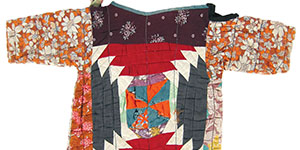
In Turkmenistan, mothers sewed short-sleeved garments (kurte) for their children using multicolored pieces of cotton fabric with thick, heavy thread so that the life of the child would be strong and long, while hems remained raw so as not to stunt the child’s growth. As in textiles of antiquity, where charms and amulets functioned magically to ward off evil, the triangle (tumar), considered an amulet in itself, was placed on the shoulders and back of garments to protect against an attack where the child is most vulnerable. A child’s first haircut at one year is an important ritual in Central Asia and mothers often attached the hair of an older, healthy child to a newborn’s garment as a good luck talisman, especially if a previous infant had died. Children also wore a kirlik, a bib-like garment composed of patches, appliqué, embroidery, or a combination, over the kurte, which provided additional protection.
Russian ethnographer Nina Lobacheva described the special dress elek, worn by young children in Khorezm, Uzbekistan, made of multicolored materials with triangles in place of sleeves and decorated with buttons or fringes. She suggests that some ritual in the childhood cycle must have been associated with this garment, an interpretation favored by the numerous amulets attached. Children’s quilted hats were traditional in this region, as well.